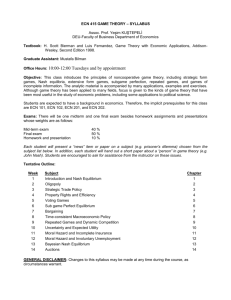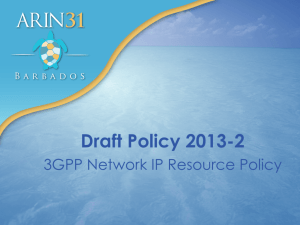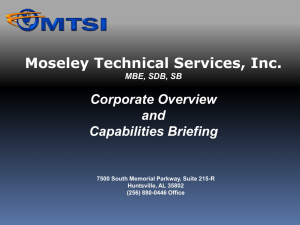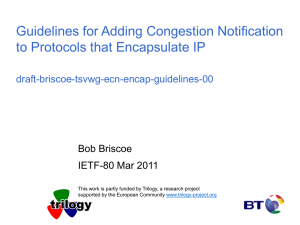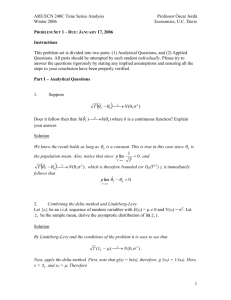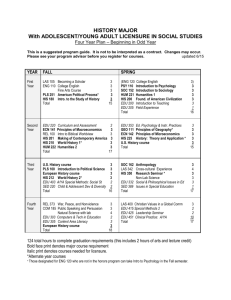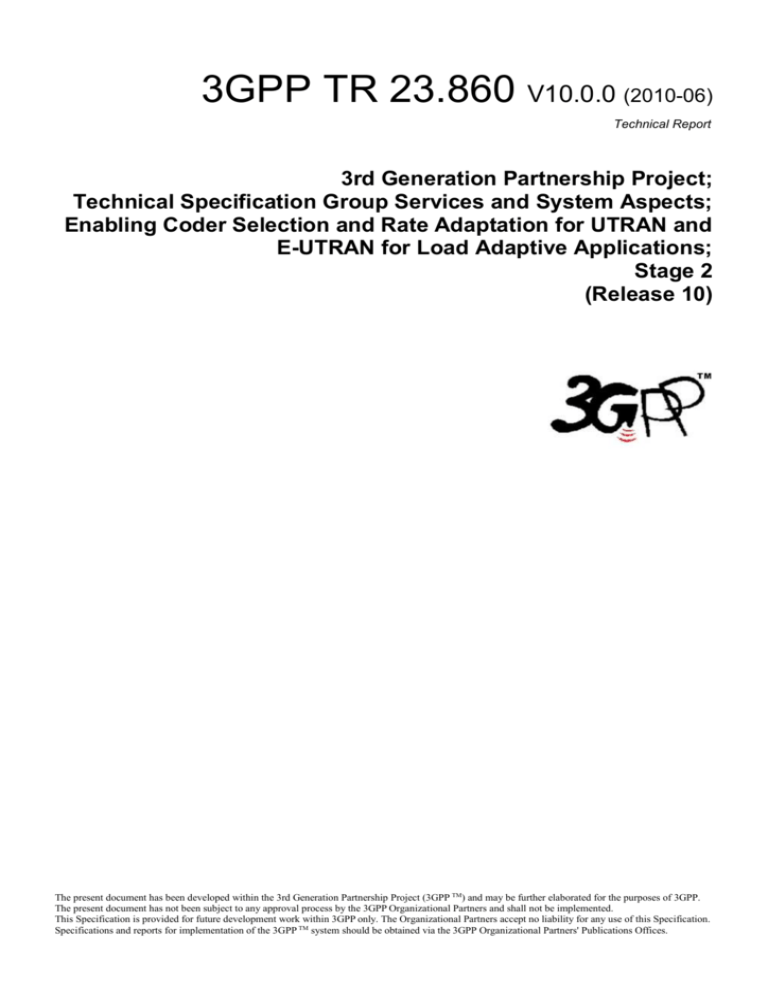
3GPP TR 23.860 V10.0.0 (2010-06)
Technical Report
3rd Generation Partnership Project;
Technical Specification Group Services and System Aspects;
Enabling Coder Selection and Rate Adaptation for UTRAN and
E-UTRAN for Load Adaptive Applications;
Stage 2
(Release 10)
The present document has been developed within the 3rd Generation Partnership Project (3GPP TM) and may be further elaborated for the purposes of 3GPP.
The present document has not been subject to any approval process by the 3GPP Organizational Partners and shall not be implemented.
This Specification is provided for future development work within 3GPP only. The Organizational Partners accept no liability for any use of this Specification.
Specifications and reports for implementation of the 3GPP TM system should be obtained via the 3GPP Organizational Partners' Publications Offices.
Release 10
2
3GPP TR 23.860 V10.0.0 (2010-06)
Keywords
3GPP
Postal address
3GPP support office address
650 Route des Lucioles - Sophia Antipolis
Valbonne - FRANCE
Tel.: +33 4 92 94 42 00 Fax: +33 4 93 65 47 16
Internet
http://www.3gpp.org
Copyright Notification
No part may be reproduced except as authorized by written permission.
The copyright and the foregoing restriction extend to reproduction in all media.
© 2010, 3GPP Organizational Partners (ARIB, ATIS, CCSA, ETSI, TTA, TTC).
All rights reserved.
UMTS™ is a Trade Mark of ETSI registered for the benefit of its members
3GPP™ is a Trade Mark of ETSI registered for the benefit of its Members and of the 3GPP Organizational Partners
LTE™ is a Trade Mark of ETSI currently being registered for the benefit of its Members and of the 3GPP Organizational Partners
GSM® and the GSM logo are registered and owned by the GSM Association
3GPP
Release 10
3
3GPP TR 23.860 V10.0.0 (2010-06)
Contents
Foreword............................................................................................................................................................. 4
1
Scope ........................................................................................................................................................ 5
2
References ................................................................................................................................................ 5
3
Definitions and abbreviations................................................................................................................... 6
3.1
3.2
4
4.1
4.2
Definitions ......................................................................................................................................................... 6
Abbreviations ..................................................................................................................................................... 6
Requirements............................................................................................................................................ 6
General............................................................................................................................................................... 6
Functional Requirements ................................................................................................................................... 6
5
Rate Adaptation in Release 9 (Informative) ............................................................................................. 7
6
Solutions ................................................................................................................................................... 8
6.1
6.2
6.2.1
6.2.2
6.3
6.4
6.4.1
6.4.2
6.4.3
6.4.4
6.4.5
6.4.6
6.4.7
6.5
Codec selection during call establishment phase ............................................................................................... 8
Codec rate adaptation during call establishment phase ...................................................................................... 8
Codec data rate adaptation for voice during call establishment phase over UTRA/HSPA .......................... 8
Codec data rate adaptation for non-voice RTP-based services during call establishment phase over
UTRA/HSPA and E-UTRA ......................................................................................................................... 8
Mid call rate adaptation ..................................................................................................................................... 9
ECN support & Codec rate adaptation by IMS Core Network entities .............................................................. 9
General ......................................................................................................................................................... 9
CS GERAN/UTRAN Interworking at MGCF/IM-MGW ............................................................................ 9
Interworking with non-ECN IP network and/or terminal at IBCF/TrGW .................................................. 10
Interworking with non-3GPP ECN IP terminal at IBCF/TrGW ................................................................ 11
ECN support at IMS-ALG/IMS-AGW ...................................................................................................... 11
ECN support at MRFC/MRFP ................................................................................................................... 12
CS GERAN/UTRAN Interworking at the MSC Server enhanced for ICS/SRVCC / CS-MGW ............... 12
Setting of Maximum Bit Rate (MBR) to be greater than the Guaranteed Bit Rate (GBR) over E-UTRA ...... 12
7
Assessment ............................................................................................................................................. 13
8
Conclusion.............................................................................................................................................. 13
Annex A (informative):
Change history ............................................................................................... 14
3GPP
Release 10
4
3GPP TR 23.860 V10.0.0 (2010-06)
Foreword
This Technical Specification has been produced by the 3 rd Generation Partnership Project (3GPP).
The contents of the present document are subject to continuing work within the TSG and may change following formal
TSG approval. Should the TSG modify the contents of the present document, it will be re-released by the TSG with an
identifying change of release date and an increase in version number as follows:
Version x.y.z
where:
x the first digit:
1 presented to TSG for information;
2 presented to TSG for approval;
3 or greater indicates TSG approved document under change control.
y the second digit is incremented for all changes of substance, i.e. technical enhancements, corrections,
updates, etc.
z the third digit is incremented when editorial only changes have been incorporated in the document.
3GPP
Release 10
1
5
3GPP TR 23.860 V10.0.0 (2010-06)
Scope
The system enhancements to enable codec rate adaptation at voice call setup over E-UTRA was standardized in Rel-9 in
TS 23.401 [2].
The scope of this document is to study and specify enhancements to existing codec selection and codec rate adaptation
based on network loading conditions and operator policies over UTRA and E-UTRA. Potential enhancements are
definition of the signalling and interfaces enabling:
-
To perform codec selection based on network loading conditions and operator policies during call establishment
phase over both UTRA and E-UTRA;
-
To perform codec data rate adaptation (if possible for the selected codec and needed by the service) based on
network loading conditions during call establishment phase over UTRA;
-
To perform codec data rate adaptation (if possible for the selected codec and needed by the service) for nonvoice RTP-based services based on network loading conditions at call setup over E-UTRA;
-
To perform codec data rate adaptation (if possible for the selected codec and needed by the service) based on
network loading indications during an on-going call over both UTRA and E-UTRA;
-
Support of codec rate adaptation by IMS Core Network entities (e.g., MGCF/MGW, IBCF/TrGW, etc.);
-
Setting of Maximum Bit Rate (MBR) to be greater than the Guaranteed Bit Rate (GBR) over E-UTRA.
The solutions can be moved to normative specifications independently of each other once the study on the particular
solution has been concluded.
2
References
The following documents contain provisions which, through reference in this text, constitute provisions of the present
document.
References are either specific (identified by date of publication, edition number, version number, etc.) or
non-specific.
For a specific reference, subsequent revisions do not apply.
For a non-specific reference, the latest version applies. In the case of a reference to a 3GPP document (including
a GSM document), a non-specific reference implicitly refers to the latest version of that document in the same
Release as the present document.
[1]
3GPP TR 21.905: "Vocabulary for 3GPP Specifications".
[2]
3GPP TS 23.401: "General Packet Radio Service (GPRS) enhancements for Evolved Universal
Terrestrial Radio Access Network (E-UTRAN) access".
[3]
3GPP TS 36.300: "Evolved Universal Terrestrial Radio Access (E-UTRA) and Evolved Universal
Terrestrial Radio Access Network (E-UTRAN); Overall description; Stage 2".
[4]
3GPP TS 26.114: "IP Multimedia Subsystem (IMS); Multimedia Telephony; Media handling and
interaction".
[5]
3GPP TR 22.813: "Study of Use Cases and Requirements for Enhanced Voice Codecs for the
Evolved Packet System (EPS)".
[6]
IETF RFC 3168 (2001): "The Addition of Explicit Congestion Notification (ECN) to IP", K.
Ramakrishnan, S. Floyd and D. Black.
[7]
IETF Internet draft (2010): "Explicit Congestion Notification (ECN) for RTP over UDP", M.
Westerlund, et. al., http://www.ietf.org/id/draft-ietf-avt-ecn-for-rtp-01.txt.
3GPP
Release 10
6
3GPP TR 23.860 V10.0.0 (2010-06)
[8]
3GPP TS 29.163: "Interworking between the IM CN subsystem and CS networks – Stage 3".
[9]
3GPP TS 23.333: "Multimedia Resource Function Controller (MRFC) – Multimedia Resource
Function Processor (MRFP) Mp interface: Procedures Descriptions."
3
Definitions and abbreviations
3.1
Definitions
For the purposes of the present document, the terms and definitions given in TR 21.905 [1] a apply.
3.2
Abbreviations
For the purposes of the present document, the abbreviations given in 3GPP TR 21.905 [1] and the following apply.
ECN
Explicit Congestion Notification
4
Requirements
4.1
General
Following are the general requirements for the Codec rate adaptation enhancements to be studied:
1. Codec rate adaptation enhancements shall not negatively affect the operation of pre-Rel-10 UEs.
2. A UE-internal interface between the application being adapted and the layer responsible for forwarding the
indications of the need to rate adapt is necessary and is assumed to be available. The definition of this interface is
beyond the scope of this study.
3. It shall be possible to apply Codec rate adaption when interworking with external networks (e.g. PSTN, non IMS
networks).
4. The Codec rate adaptation shall be applicable for audio and video media types.
Editor's note: Mechanisms to avoid potential conflict between ECN-based congestion control and ARP-based
admission control should be studied.
4.2
Functional Requirements
Following are the requirements for solutions that are to provide the Codec rate adaptation enhancements:
1. It should be possible to enforce Code rate adaptation for UEs which support these features when connected
through a network which supports Codec rate adaptation independent of the remote UE/network's support for
these features.
2. The procedures for Codec rate adaptation during an on-going session shall not cause a SIP re-negotiation.
3. The procedures for Codec rate adaptation during an on-going session shall allow the network to indicate to the
UE that it should decrease its Codec rate.
NOTE:
The UE can increase its Codec rate in the absence of congestion indication and if permitted by application
layer configuration (e.g., see the 'ECN_congestion_wait' parameter specified in TS 26.114 [4]).
4. The Codec rate adaptation enhancements shall not require the eNB or RNC to have knowledge of the Codec
selected for the multimedia session, so that future Codecs can be supported and enhancements of policies can be
made without requiring impact to the RAN or upgrade of the RAN functional entities.
3GPP
Release 10
5
7
3GPP TR 23.860 V10.0.0 (2010-06)
Rate Adaptation in Release 9 (Informative)
The rate adaption procedures defined in Rel-9 of TS 23.401 [2], TS 36.300 [3], TS 26.114 [4] are based on using ECN
indications from the eNB to the UEs in the E-UTRA. MTSI terminals that support ECN can be configured to enable use
of ECN to trigger rate adaptation for voice encoders in MTSI clients.
When ECN is enabled in the MTSI client, SDP Offer and Answer procedures are used to negotiate ECN usage between
the MTSI clients in 3GPP networks that properly handle ECN-marked packets. Once ECN usage has been negotiated at
session set-up terminals begin marking voice media packets with the ECT(0) codepoint. This serves as an indication to
the intermediate routers and eNB that the MTSI clients are able to properly handle ECN-marked packets.
NOTE:
A non-MTSI client may also use the ECT(1) codepoint to indicate that the client is ECN capable.
If an eNB that supports ECN detects congestion on the downlink for voice RTP media it may re-mark ECT-marked
downlink packets with the ECN-CE codepoint to indicate "congestion experienced" (see Figure 1). Upon receiving this
ECN-CE marked packet MTSI Client A determines if a new rate needs to be requested of the voice media sender. The
procedures through which the media receiver determines what rate to request of the media sender can be configured by
the operator and are described in TS 26.114 [4]. If a rate request is necessary the receiving MTSI client sends a rate
request to the media sender in MTSI Client B to lower its transmission rate.
MTSI
Client
A
eNB
A
ECN -CE Marked Packet
MTSI
Client
B
eNB
B
ECT( 0) Marked RTP- Voice Packets
Rate Adaptation Request
Rate -Reduced
ECN -CE Marked Packet
ECT( 0) Mar ked RT P- Voice Pac kets
Figure 1: ECN-triggered rate adaptation to downlink congestion
If an eNB that supports ECN detects congestion on the uplink for a voice media RTP flow it may re-mark ECT-marked
uplink packets with the ECN-CE codepoint to indicate "congestion experienced" (see Figure 2). Upon receiving this
ECN-CE marked packet MTSI Client B determines if a new rate needs to be requested of the voice media sender. The
procedures through which the media receiver determines what rate to request of the media sender can be configured by
the operator and are described in TS 26.114 [4]. If a rate request is necessary the receiving MTSI client sends a rate
request to the media sender in MTSI client A to lower its transmission rate.
3GPP
Release 10
8
MTSI
Client
A
eNB
A
3GPP TR 23.860 V10.0.0 (2010-06)
eNB
B
ECT (0) Marked RTP- Voice
Packets
MTSI
Client
B
ECN- CE Marked Packet
Rate Adaptation Request
Rate -Reduced
ECT( 0) Marked Packets
ECN- CE Marked Packet
Figure 2: ECN-triggered rate adaptation to uplink congestion
TS 26.114 [4] also specifies procedures on how an MTSI MGW performs inter-working with:
-
CS networks;
-
Other IP networks and devices that do not support ECN;
-
Other IP networks that support ECN not according to TS 26.114 [4].
6
Solutions
6.1
Codec selection during call establishment phase
The 3GPP adaptive multi-rate voice codecs (AMR and AMR-WB) and the upcoming EVS codec are all capable of
adapting to narrow-band, and their lowest bit rate will be approximately the same TR 22.813 [5]. Therefore, there is no
requirement for voice codec selection based on network loading conditions.
In a terminal with multiple video codecs, we expect that all video codecs would be able to reduce their data rate as
needed. Therefore, there is no requirement for video codec selection based on network loading conditions.
No requirements for codec selection based on network loading conditions have been identified. The study of this aspect
is concluded. There are no impacts on any 3GPP technical specifications resulting from this aspect.
6.2
Codec rate adaptation during call establishment phase
6.2.1
Codec data rate adaptation for voice during call establishment
phase over UTRA/HSPA
For voice RTP-based services, UTRA/HSPA can use the ECN procedures described in clause 5.
6.2.2
Codec data rate adaptation for non-voice RTP-based services
during call establishment phase over UTRA/HSPA and E-UTRA
The ECN framework described in clause 5 can be used with video over UTRA/HSPA and E-UTRA. The detailed
adaptation algorithms and configuration parameters needed for ECN-triggered video rate adaptation should be studied
and specified further in SA WG4.
3GPP
Release 10
6.3
9
3GPP TR 23.860 V10.0.0 (2010-06)
Mid call rate adaptation
Codec rate adaptation in general - and this includes 'codec rate adaptation during call establishment phase' and 'mid call
rate adaptation' - for UTRA/HSPA and E-UTRA, and for voice and video codecs based on RTP should be based on the
Explicit Congestion Notification scheme.
For E-UTRA SA2 work has not identified any additional aspects to be specified so far beyond what has already been
specified in Rel-9 TS 36.300 [3]. For UTRA/HSPA support for ECN needs to be specified in RAN2 similar to how
support for ECN has been specified for E UTRA in Rel-9 TS 36.300 [3].
For voice codecs SA2 work has not identified any additional aspects to be specified so far beyond what has already
been specified in Rel-9 TS 26.114 [4]. For video codecs the specification of an ECN-based codec rate adaptation
scheme is to be addressed in SA WG4.
6.4
ECN support & Codec rate adaptation by IMS Core Network
entities
6.4.1
General
The ECN framework used to signal radio congestion and trigger codec rate adaptation affects the following IMS CN
entities: MGCF/IM-MGW, IBCF/TrGW, IMS-ALG/ IMS-AGW, MRFP/MRFC, and the MSC Server enhanced for
ICS/SRVCC / CS-MGW.
As specified in TS 26.114 [4],
-
an MGCF/IM-MGW supporting MTSI can be used for inter-working between an ECN-capable client in a 3GPP
network that properly handles ECN-marked packets and a CS network;
-
an IBCF/TrGW supporting MTSI can be used for interworking between an ECN-capable client in a 3GPP
network that properly handles ECN-marked packets, and:
-
a remote client that does not use ECN;
-
a remote client that supports ECN in different way than what is specified for MTSI clients;
-
a network which does not handle ECN-marked packets properly.
6.4.2
CS GERAN/UTRAN Interworking at MGCF/IM-MGW
In order to support MTSI-compliant ECN, MGCF/IM-MGW shall:
-
support ECN as described in TS 26.114 [4] for the MTSI client in terminal (including IETF RFC 3168 [6] and
IETF Draft on ECN for RTP over UDP [7]), except that the MGCF and IM-MGW do not determine whether
ECN can be used based on the Radio Access Technology that is used towards the MTSI client in terminal; the
MGCF/ IM-MGW act as an ECN endpoint towards the MTSI client in terminal;
-
support RTP/AVPF and SDPCapNeg;
-
be capable of enabling end-to-end rate adaptation between the MTSI client in terminal and the CS terminal or
IM-MGW by performing the following:
-
negotiate the use of ECN with the MTSI client in terminal, if it can be confirmed that the network used
towards the MTSI client in terminal properly handles ECN-marked packets;
NOTE 1: An operator can ensure that the network used towards the MTSI client in terminal properly handles ECNmarked packets by setting corresponding requirements on network equipment, and verifying that those
requirements are met. No active signalling ("probing") during normal operation is required to ensure this.
-
trigger rate adaptation request towards the MTSI client in terminal when receiving in the incoming IMS
media flow IP packets marked with ECN-CE, regardless of whether the IM-MGW applies or does not apply
transcoding;
3GPP
Release 10
10
3GPP TR 23.860 V10.0.0 (2010-06)
-
inter-work adaptation requests between the MTSI client in terminal and the CS GERAN/UTRAN when the
IM-MGW bridges compatible codec configurations between the interfaces without applying a transcoding
function (existing requirement); if the IM-MGW prefers to receive a lower codec mode rate from the MTSI
client in terminal than what the CS network indicates, e.g. after having received IP packets with ECN-CE, the
IM-MGW may replace the codec mode requested from the CS side with the codec mode that the IM-MGW
prefers;
-
perform media adaptation (e.g. reduce media bit-rate) towards the MTSI client in terminal when receiving
from the latter an adaptation request and the IM-MGW applies transcoding (existing requirement).
NOTE 2: For CS interworking the MTSI MGCF/MGW does not have to perform transcoding if the same codec is
selected on the CS and PS network.
NOTE 3: TS 29.163 [8] only defines so far interworking of CS rate control requests into RTP in-band rate control
(CMR) on IMS side. It is FFS in CT WG3 if interworking with RTCP-APP adaptation requests for MTSI
needs to be specified; this is not specific to ECN.
Potential impacts to the Mn procedures and profile have to be studied and corresponding stage 2 and stage 3
requirements be documented in CT WG3 and CT WG4, e.g. configuring the IMS termination to use ECN (with its ECN
parameters e.g. ECT(0), leap-of-faith method, etc.).
6.4.3
Interworking with non-ECN IP network and/or terminal at
IBCF/TrGW
An IBCF/TrGW supporting MTSI compliant ECN can be used to enable ECN within the local network when either the
remote network cannot be confirmed to properly handle ECN-marked packets or the remote terminal does not support
or use ECN.
In order to support MTSI compliant ECN when interworking with a remote network that cannot be confirmed to
properly handle ECN-marked packets and/or with a remote terminal does not support or use ECN, the IBCF/TrGW
shall:
-
determine from local configuration if the remote network properly handles ECN-marked packets;
-
determine with SDP offer/answer procedures if the remote terminal supports ECN;
-
support RTP/AVPF and SDPCapNeg;
-
be capable of enabling end-to-end rate adaptation between the local MTSI client in terminal and the remote
client or TrGW by performing the following towards the local MTSI client in terminal:
-
negotiate the use of ECN;
-
support ECN as described in this specification for the MTSI client in terminal (including IETF RFC 3168 [6]
and IETF Draft on ECN for RTP over UDP [7]), except that the MTSI IBCF/TrGW does not determine
whether ECN can be used based on the Radio Access Technology; the MTSI IBCF/TrGW acts as an ECN
endpoint towards the ECN capable MTSI client in terminal;
-
trigger rate adaptation request towards the MTSI client in terminal when receiving in the incoming IMS
media flow IP packets marked with ECN-CE, regardless of whether the TrGW applies or does not apply
transcoding; this requires that the IBCF provides the TrGW with the media configuration, even if transcoding
is not supported or applied, when the IP termination is configured with ECN;
-
forward adaptation requests (see NOTE 2) between the MTSI client in terminal and the remote client when
the TrGW bridges compatible codec configurations between the interfaces without applying a transcoding
function (existing requirement); if the TrGW prefers to receive a lower codec mode rate from the MTSI
client in terminal than what the other SIP network indicates, e.g. after having received IP packets with ECNCE, the TrGW may replace the codec mode requested from the other SIP network with the codec mode that
the TrGW prefers;
-
perform media adaptation (e.g. reduce media bit-rate) towards the MTSI client in terminal when receiving
from the latter an adaptation request and the TrGW applies transcoding (existing requirement).
3GPP
Release 10
11
3GPP TR 23.860 V10.0.0 (2010-06)
NOTE 1: For this interworking the MTSI IBCF/TrGW does not have to perform transcoding if the same codec is
selected on both sides of the TrGW.
NOTE 2: It is FFS in CT WG3 if rate adaptation requests have to be interworked between RTCP-APP based and
RTP in-band rate controls if AVPF is negotiated on one side only of the IBCF, e.g. AVPF is not
supported by the non-ECN IP terminal and the ECN-capable MTSI client in terminal sends an RTCPAPP adaptation request. This is not specific to ECN.
Potential impacts to the Ix procedures and profile have to be studied and corresponding stage 2 and stage 3 requirements
be documented in CT WG3 and CT WG4, e.g. configuring whether the IMS CN termination and the other IMS/SIP
network termination shall use ECN (and if yes, with their relative ECN parameters).
6.4.4
Interworking with non-3GPP ECN IP terminal at IBCF/TrGW
An IBCF/TrGW supporting MTSI compliant ECN can also be used to enable ECN end-to-end if the remote client uses
ECN in a different way than what is described in TS 26.114 [4] for the MTSI client in terminal, e.g. if the remote client
only supports probing for the ECN initiation phase or it needs the ECN feedback.
NOTE 1: For this interworking the MTSI IBCF/TrGW does not have to perform transcoding if the same codec is
selected between both terminals.
Potential impacts to the Ix procedures and profile have to be studied and corresponding stage 2 and stage 3 requirements
be documented in CT WG3 and CT WG4.
NOTE 2: Detailed interworking requirements between 3GPP ECN and non-3GPP ECN should in particular be
carefully studied by CT WG3. This covers e.g. the need to relay ECN bits, remark ECT(0) to/from
ECT(1) IP packets between the IMS and the other SIP networks, and the possible need to support on the
other SIP network interface probing for ECN initiation phase, ECN feedback of ECN-CE marked packets,
ECN constant monitoring, use of nonce (and support of RTCP-XR report).
NOTE 3: Some requirements of TS 26.114 [4] would imply new H.248 interactions between the IBCF and TrGW.
e.g. the requirement in clause 7.3.2 that the MTSI client may initiate a session re-negotiation to disable
ECN to resolve ECN-related error cases (e.g. detecting non-ECT in received packets instead of ECT(0) or
detecting a very high packet loss rate) would imply the need for the TrGW to notify those new errors to
the IBCF.
6.4.5
ECN support at IMS-ALG/IMS-AGW
It cannot be assumed by default that an IMS-AGW will support forwarding the ECN bits.
NOTE 1: When acting in back-to-back IP host (B2BIH) mode (only mode supported so far by the Iq profile), each
H.248 IP stream endpoint represents an IP host entity, source host for outgoing traffic and destination
host for incoming traffic. The source host behaviour is defined by IETF RFC 1122, which means essential
the insertion of a default value for the 2 bits carrying the ECN. This can lead the IMS-AGW to remark
ECT marked packets to non-ECT, possibly marking packets with a CE mark as non-ECT, which could
force the network into serious congestion due to non-responsiveness and thus significant impacts to media
quality.
The P-CSCF shall be able to disallow the negotiation of ECN during SDP offer/answer exchanges if the IMS-AGW
does not support transparent forwarding of the ECN bits or if the IMS core network or the access network used towards
the MTSI client in terminal do not properly handle ECN-marked packets.
An IMS-AGW supporting ECN shall be able to forward the ECN bits, under control from the IMS-ALG.
Potential impacts to the Iq procedures and profile have to be studied and corresponding stage 2 and stage 3 requirements
be documented in CT WG4.
NOTE 2: ECN support by the IMS-ALG/IMS-AGW is limited to transparently forwarding (or not forwarding)
ECN bits. i.e. there is no requirement, like for MGCF/IM-MGW or IBCF/TrGW, to support interworking
between 3GPP ECN and no ECN or non-3GPP ECN.
3GPP
Release 10
6.4.6
12
3GPP TR 23.860 V10.0.0 (2010-06)
ECN support at MRFC/MRFP
An MRFC/MRFP supporting MTSI-compliant ECN may act as an ECN endpoint to enable ECN with a local ECNcapable MTSI client in terminal within a local network that properly handles ECN-marked packets, when applying the
following functions (see TS 23.333 [9]):
-
play tone, play audio or multimedia announcement;
-
audio or multimedia record;
-
text to speech;
-
automatic speech recognition;
-
audio or video transcoding;
-
audio or multimedia conferencing.
This requires that the MRFC/MRFP performs the following:
-
support RTP/AVPF and SDPCapNeg;
-
be capable of enabling end-to-end rate adaptation between the local MTSI client in terminal and the MRFP by
performing the following towards the local MTSI client in terminal:
-
negotiate the use of ECN;
-
support ECN as described in TS 26.114 [4] for the MTSI client in terminal (including IETF RFC 3168 [6]
and IETF Draft on ECN for RTP over UDP [7]), except that the MTSI MRFC/MRFP does not determine
whether ECN can be used based on the Radio Access Technology; the MTSI MRFC/MRFP acts as an ECN
endpoint towards the ECN capable MTSI client in terminal;
-
trigger rate adaptation request towards the MTSI client in terminal when receiving in the incoming IMS
media flow IP packets marked with ECN-CE;
-
perform media adaptation (e.g. reduce media bit-rate) towards the MTSI client in terminal when receiving
from the latter an adaptation request.
Potential impacts to the Mp procedures and profile have to be studied and corresponding stage 2 and stage 3
requirements be documented in CT WG4.
6.4.7
CS GERAN/UTRAN Interworking at the MSC Server enhanced for
ICS/SRVCC / CS-MGW
In order to support MTSI-compliant ECN, the MSC Server enhanced for ICS/SRVCC / CS-MGW shall support the
requirements specified in clause 6.4.2 respectively for the MGCF and IM-MGW.
Potential impacts to the Mc procedures and profile have to be studied and corresponding stage 2 and stage 3
requirements be documented in CT WG3 and CT WG4, e.g. configuring the IMS termination to use ECN (with its ECN
parameters e.g. ECT(0), leap-of-faith method…).
6.5
Setting of Maximum Bit Rate (MBR) to be greater than the
Guaranteed Bit Rate (GBR) over E-UTRA
The definition of MBR allows elastic applications (such as video) to make use of additional network resources that
might be available for non-guaranteed periods of time. This allows the applications to take advantage of additional
capacity when it is available while being flexible enough to react when such resources are no longer available to the
application.
To achieve the gains for MBR it is necessary to support configuration of the MBR value greater than the GBR value. It
should also be noted that setting MBR greater than GBR is already supported in UTRAN and such a configuration
should also be supported for E-UTRAN.
3GPP
Release 10
13
3GPP TR 23.860 V10.0.0 (2010-06)
To make MBR>GBR bearers useful for a 3GPP application / service (e.g., MTSI) based on a bit rate adaptive codec
requires that when sending beyond GBR the media end-points become aware of incipient congestion ahead of time.
This is to allow the media end-point to trigger a codec rate reduction before packets need to be dropped in the network.
With the Explicit Congestion Notification (ECN) scheme supported for UTRA/HSPA and E-UTRA, and for voice and
video Codecs this requirement is met. So given that the media end-points have successfully negotiated the use of ECN
no problem has been identified with simply allowing MBR>GBR bearers.
No additional functionality has been identified beyond what has already been specified in Rel-8 that would be required
from a UE to support MBR>GBR bearers. On NAS level a UE shall anyway not reject a dedicated bearer based on QoS
parameters (see dedicated establishment procedure in 23.401: "The UE may provide the EPS Bearer QoS parameters to
the application handling the traffic flow. The application usage of the EPS Bearer QoS is implementation dependent.
The UE shall not reject the RRC Connection Reconfiguration on the basis of the EPS Bearer QoS parameters contained
in the Session Management Request.").
SA4 has stated [S4-070314] that for 3GPP services like MTSI packet dropping is not an acceptable means to trigger a
codec rate reduction. In particular for video the error propagation may greatly damage video quality. SA WG4 even
states: "Dropping packets may actually increase the media bit rate if e.g. frame redundancy is invoked due to degraded
channel conditions." This is why an operator may want to configure a policy that the PCRF shall check that the endpoints have successfully negotiated the use of ECN, i.e. that a congestion pre-warning scheme has been put in place,
before the network sets MBR>GBR for 3GPP services like MTSI. Note that MBR>GBR is allowed already in 2G/3G
pre-Rel-8.
7
Assessment
No assessment of alternatives were required since only one alternative was identified.
8
Conclusion
The following conclusions have been agreed:
-
Voice and Video Codec selection based on network loading conditions is not required.
-
The ECN-based rate adaptation procedures defined for RTP-based voice services in E-UTRA (Rel-9) can be
reused for RTP-based voice services in UTRA/HSPA. Further work on support of this capability is not expected
in SA WG2.
-
The ECN-based rate adaptation framework defined for RTP-based voice services in E-UTRA (Rel-9) can be
reused for RTP-based video services in E-UTRA and UTRA/HSPA. Further study of the detailed procedures for
how MTSI clients should adapt their video encoding rates in response to ECN indications is out of scope for
SA WG2.
-
The procedures and requirements on impacted IMS CN entities to support ECN are as outlined in clause 6.4
-
Support the standardization of MBR>GBR in E-UTRA as outlined in clause 6.5.
3GPP
Release 10
14
3GPP TR 23.860 V10.0.0 (2010-06)
Annex A (informative):
Change history
Date
06-2010
TSG #
SP-48
TSG Doc.
SP-100356
CR
-
06-2010
SP-48
-
-
Rev Subject/Comment
MCC update to version 2.0.0 for presentation to TSG SA for
Approval
MCC update to version 10.0.0 after TSG SA approval
(Release 10)
3GPP
Old
1.1.0
New
2.0.0
2.0.0
10.0.0

